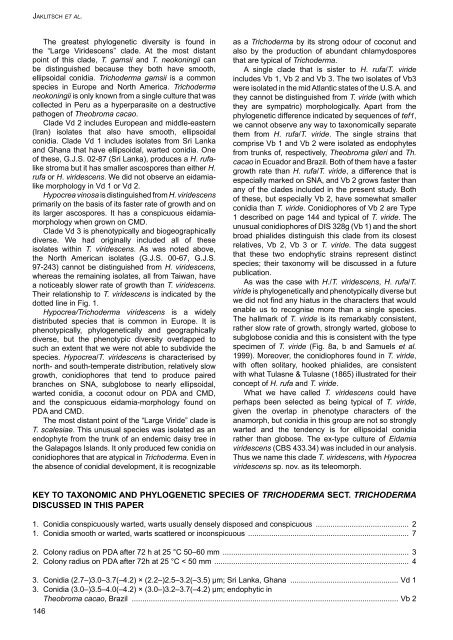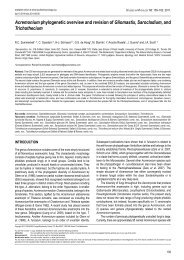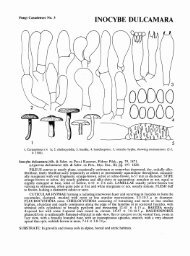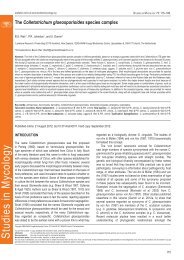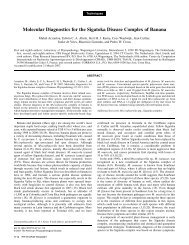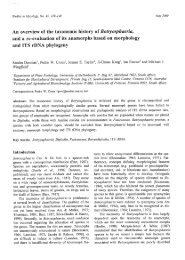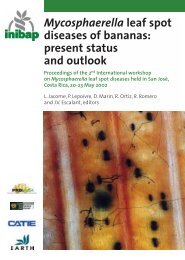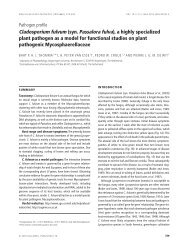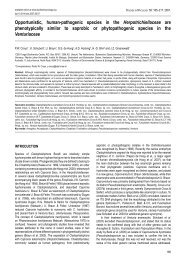Hypocrea rufa/Trichoderma viride: a reassessment, and ... - CBS
Hypocrea rufa/Trichoderma viride: a reassessment, and ... - CBS
Hypocrea rufa/Trichoderma viride: a reassessment, and ... - CBS
Create successful ePaper yourself
Turn your PDF publications into a flip-book with our unique Google optimized e-Paper software.
JAKLITSCH ET AL.<br />
The greatest phylogenetic diversity is found in<br />
the “Large Viridescens” clade. At the most distant<br />
point of this clade, T. gamsii <strong>and</strong> T. neokoningii can<br />
be distinguished because they both have smooth,<br />
ellipsoidal conidia. <strong>Trichoderma</strong> gamsii is a common<br />
species in Europe <strong>and</strong> North America. <strong>Trichoderma</strong><br />
neokoningii is only known from a single culture that was<br />
collected in Peru as a hyperparasite on a destructive<br />
pathogen of Theobroma cacao.<br />
Clade Vd 2 includes European <strong>and</strong> middle-eastern<br />
(Iran) isolates that also have smooth, ellipsoidal<br />
conidia. Clade Vd 1 includes isolates from Sri Lanka<br />
<strong>and</strong> Ghana that have ellipsoidal, warted conidia. One<br />
of these, G.J.S. 02-87 (Sri Lanka), produces a H. <strong>rufa</strong>like<br />
stroma but it has smaller ascospores than either H.<br />
<strong>rufa</strong> or H. <strong>viride</strong>scens. We did not observe an eidamialike<br />
morphology in Vd 1 or Vd 2.<br />
<strong>Hypocrea</strong> vinosa is distinguished from H. <strong>viride</strong>scens<br />
primarily on the basis of its faster rate of growth <strong>and</strong> on<br />
its larger ascospores. It has a conspicuous eidamiamorphology<br />
when grown on CMD.<br />
Clade Vd 3 is phenotypically <strong>and</strong> biogeographically<br />
diverse. We had originally included all of these<br />
isolates within T. <strong>viride</strong>scens. As was noted above,<br />
the North American isolates (G.J.S. 00-67, G.J.S.<br />
97-243) cannot be distinguished from H. <strong>viride</strong>scens,<br />
whereas the remaining isolates, all from Taiwan, have<br />
a noticeably slower rate of growth than T. <strong>viride</strong>scens.<br />
Their relationship to T. <strong>viride</strong>scens is indicated by the<br />
dotted line in Fig. 1.<br />
<strong>Hypocrea</strong>/<strong>Trichoderma</strong> <strong>viride</strong>scens is a widely<br />
distributed species that is common in Europe. It is<br />
phenotypically, phylogenetically <strong>and</strong> geographically<br />
diverse, but the phenotypic diversity overlapped to<br />
such an extent that we were not able to subdivide the<br />
species. <strong>Hypocrea</strong>/T. <strong>viride</strong>scens is characterised by<br />
north- <strong>and</strong> south-temperate distribution, relatively slow<br />
growth, conidiophores that tend to produce paired<br />
branches on SNA, subglobose to nearly ellipsoidal,<br />
warted conidia, a coconut odour on PDA <strong>and</strong> CMD,<br />
<strong>and</strong> the conspicuous eidamia-morphology found on<br />
PDA <strong>and</strong> CMD.<br />
The most distant point of the “Large Viride” clade is<br />
T. scalesiae. This unusual species was isolated as an<br />
endophyte from the trunk of an endemic daisy tree in<br />
the Galapagos Isl<strong>and</strong>s. It only produced few conidia on<br />
conidiophores that are atypical in <strong>Trichoderma</strong>. Even in<br />
the absence of conidial development, it is recognizable<br />
146<br />
as a <strong>Trichoderma</strong> by its strong odour of coconut <strong>and</strong><br />
also by the production of abundant chlamydospores<br />
that are typical of <strong>Trichoderma</strong>.<br />
A single clade that is sister to H. <strong>rufa</strong>/T. <strong>viride</strong><br />
includes Vb 1, Vb 2 <strong>and</strong> Vb 3. The two isolates of Vb3<br />
were isolated in the mid Atlantic states of the U.S.A. <strong>and</strong><br />
they cannot be distinguished from T. <strong>viride</strong> (with which<br />
they are sympatric) morphologically. Apart from the<br />
phylogenetic difference indicated by sequences of tef1,<br />
we cannot observe any way to taxonomically separate<br />
them from H. <strong>rufa</strong>/T. <strong>viride</strong>. The single strains that<br />
comprise Vb 1 <strong>and</strong> Vb 2 were isolated as endophytes<br />
from trunks of, respectively, Theobroma gileri <strong>and</strong> Th.<br />
cacao in Ecuador <strong>and</strong> Brazil. Both of them have a faster<br />
growth rate than H. <strong>rufa</strong>/T. <strong>viride</strong>, a difference that is<br />
especially marked on SNA, <strong>and</strong> Vb 2 grows faster than<br />
any of the clades included in the present study. Both<br />
of these, but especially Vb 2, have somewhat smaller<br />
conidia than T. <strong>viride</strong>. Conidiophores of Vb 2 are Type<br />
1 described on page 144 <strong>and</strong> typical of T. <strong>viride</strong>. The<br />
unusual conidiophores of DIS 328g (Vb 1) <strong>and</strong> the short<br />
broad phialides distinguish this clade from its closest<br />
relatives, Vb 2, Vb 3 or T. <strong>viride</strong>. The data suggest<br />
that these two endophytic strains represent distinct<br />
species; their taxonomy will be discussed in a future<br />
publication.<br />
As was the case with H./T. <strong>viride</strong>scens, H. <strong>rufa</strong>/T.<br />
<strong>viride</strong> is phylogenetically <strong>and</strong> phenotypically diverse but<br />
we did not find any hiatus in the characters that would<br />
enable us to recognise more than a single species.<br />
The hallmark of T. <strong>viride</strong> is its remarkably consistent,<br />
rather slow rate of growth, strongly warted, globose to<br />
subglobose conidia <strong>and</strong> this is consistent with the type<br />
specimen of T. <strong>viride</strong> (Fig. 8a, b <strong>and</strong> Samuels et al.<br />
1999). Moreover, the conidiophores found in T. <strong>viride</strong>,<br />
with often solitary, hooked phialides, are consistent<br />
with what Tulasne & Tulasne (1865) illustrated for their<br />
concept of H. <strong>rufa</strong> <strong>and</strong> T. <strong>viride</strong>.<br />
What we have called T. <strong>viride</strong>scens could have<br />
perhaps been selected as being typical of T. <strong>viride</strong>,<br />
given the overlap in phenotype characters of the<br />
anamorph, but conidia in this group are not so strongly<br />
warted <strong>and</strong> the tendency is for ellipsoidal conidia<br />
rather than globose. The ex-type culture of Eidamia<br />
<strong>viride</strong>scens (<strong>CBS</strong> 433.34) was included in our analysis.<br />
Thus we name this clade T. <strong>viride</strong>scens, with <strong>Hypocrea</strong><br />
<strong>viride</strong>scens sp. nov. as its teleomorph.<br />
KEY TO TAXONOMIC AND PHYLOGENETIC SPECIES OF TRICHODERMA SECT. TRICHODERMA<br />
DISCUSSED IN THIS PAPER<br />
1. Conidia conspicuously warted, warts usually densely disposed <strong>and</strong> conspicuous ............................................ 2<br />
1. Conidia smooth or warted, warts scattered or inconspicuous ............................................................................ 7<br />
2. Colony radius on PDA after 72 h at 25 °C 50–60 mm ........................................................................................ 3<br />
2. Colony radius on PDA after 72h at 25 °C < 50 mm ............................................................................................ 4<br />
3. Conidia (2.7–)3.0–3.7(–4.2) × (2.2–)2.5–3.2(–3.5) μm; Sri Lanka, Ghana ................................................... Vd 1<br />
3. Conidia (3.0–)3.5–4.0(–4.2) × (3.0–)3.2–3.7(–4.2) μm; endophytic in<br />
Theobroma cacao, Brazil .............................................................................................................................. Vb 2


